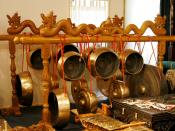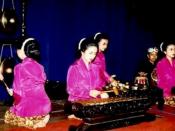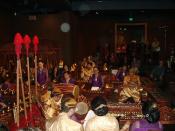The Gamelan Ensemble and its Music
The gamelan ensemble and its music are commonly found in the Indonesian countries of Java, Bali, and many others. The word gamelan describes the set of instruments which are classified by their paintings and decorations on the instruments. The gamelan ensemble usually consists of several metal bar instruments, as well as gongs. The metal bar instruments could be compared to what we might call a vibraphone. Besides gongs, the gamelan ensemble may have one or more drums, and also different native instruments.
Ancient gamelan ensembles were smaller in size with only a few gongs and one or two drums.� In today's ensemble, the ensemble is much larger. The larger ensemble has many more gongs, a couple more drums, and they also add in native instruments such as bamboo flutes, xylophones, zithers, and even fiddles.�
The Gamelan instrumentation varies from which ensemble you may be hearing, and/or participating in.
There are four main categories of gamelan instruments. There are the gong-instruments, the metal-keyed instruments, the drums, and other melodic instruments.� When we talk about the gong instruments they can be classified as hanging gongs or kettle gongs. Among the hanging gongs, there are three sizes. The largest hanging gong is called the gong ageng.� This gong is the stereotypical gong that you may see on television or in most Indonesian culture. The middle sized hanging gong is called the siyem. The kempul is the smallest of the hanging gong family.� The kempul will also be the most used hanging gong in the ensemble. When we are analyzing kettle gongs you can either have a single kettle gong or sets of kettle gongs.� The kenong is the only single kettle gong. It is also the largest of all the kettle gongs. The kethuk, kempyang, bonang barung,


